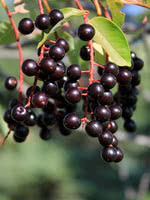Mon-Fri 9am - 5pm Mountain time
Western Chokecherry vs Garrington Chokecherry
Prunus virginiana var. demissa
Prunus virginiana Garrington
SOLD OUT
NOT AVAILABLE THIS SEASON - MIGHT RETURN
Western Chokecherry is a shrub or small tree commonly used for farmstead and field windbreaks.
It produces white flowers in the spring and edible dark purple fruit that matures between September and October. Its cherries are great for making for making jams, jellies or wine, but are not very palatable for raw eating.
Garrington Chokecherry is a self-fertile and rare chokecherry that is commonly used for commercial orchards. This highly prized selection is known for its heavy yields of large, reddish-black fruit that are easily harvested with an over row harvester.
Garrington Chokecherry is also commonly used for hedges and edible landscaping. This shrubs' chokecherries are commonly used in baking, preserves, wine, and jams or jellies.
Western Chokecherry Quick Facts
Garrington Chokecherry Quick Facts
Toxicity: toxic to horses, cattle, etc.)

